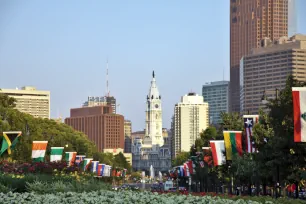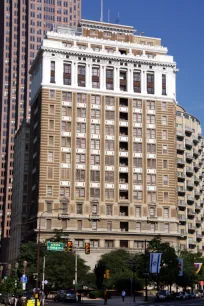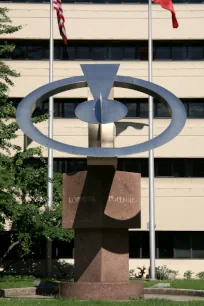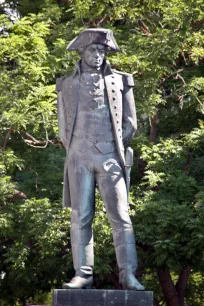Benjamin Franklin Parkway is Philadelphia’s most famous street, fittingly named after the city’s most famous resident. The street is lined with some of Philadelphia’s most important institutions, including several museums.
History
First Plans


As early as 1871, a proposal was submitted to the city council to create a wide road connecting Philadelphia’s administrative center with the city’s large green lung, Fairmount Park. Multiple plans for the new road were proposed until finally in 1907 a committee of experts created a plan that found universal approval and construction started that same year.
To make way for the new boulevard, hundreds of residential buildings in the neighborhoods along the planned parkway were razed, decimating the population in the area. Many of the new buildings that had been planned along the Parkway were never realized due to the Great Depression. As a result, the parkway’s surroundings, particularly the northwest section, can still feel a bit devoid of life.

1917 Plan
The original plan from 1907 called for an urban boulevard lined by impressive buildings, much like the Champs-Elysées in Paris. In 1917 the Fairmount Park Commissioners accepted a modified plan by Jacques Gréber, an urban architect who worked in collaboration with Paul Cret, a member of the 1907 committee. The revised plan, implemented in 1918, called for more green space and divided the wide boulevard into two different sections.
One section, stretching from Logan Square to Eakins Oval, consists of one wide avenue with park-like roads on each side. Surrounded by greenery, this part of the Benjamin Franklin Parkway is the boulevard’s most beautiful.
The other section of the parkway, connecting the City Hall with Logan Square, is of a more modest nature and is more densely built with high-rises lining the street.
Logan Square


The two sections are joined together by a grand traffic circle, Logan Square. Originally one of the five squares in William Penn’s original plan for Philadelphia, it was redesigned by Gréber as a large traffic circle similar to the Place de la Concorde. Due to its changed shape, the square is now also known as Logan Circle.
At its center is the majestic Swann Memorial Fountain. The fountain was built in 1924 by the Philadelphia Fountain Society. There are also several memorials on and around the square, including two war memorials.
Sights and attractions
Flags of the Nations
The flags that line Benjamin Franklin Parkway were first installed in 1976, during the city’s bicentennial celebration. There are about ninety flags that represent nations from around the world. Only those countries that have a significant population in Philadelphia are represented. The flags are hung on Memorial Day weekend (last Monday of May).

Grand Buildings
A number of grand buildings, home to commercial, religious, cultural and educational institutions, are clustered along the parkway.
The first part of the boulevard was reserved for commercial institutions, which built some magnificent high-rises in the Beaux-Arts style. One such building is the former Insurance Company of North America Building (now 1631 Arch Street), a magnificent 19-story tall building from 1925, situated at the foot of the Benjamin Franklin Parkway, near JFK Plaza. Nearby, on Arch Street, is the equally grand former Telephone Exchange building, built in 1915.
The middle section of the Benjamin Franklin Parkway, around Logan Square, was allocated for educational institutions. The Free Library of Philadelphia was the first to settle here, opening its doors in 1927. The Free Library and its mirror image the Philadelphia Family Court were modeled after the Hôtel de la Marine and Hôtel de Crillon, two palatial buildings on the Place de la Concorde.

To the south of Logan Square is the Cathedral of SS. Peter and Paul, one of the few buildings along the Parkway that predate its construction.
Logan Square also marks the start of Philadelphia’s museum district. Here we find the Franklin Institute Science Museum and the Academy of Natural Sciences. Towards the north the Parkway is bordered by the Barnes Foundation, the Rodin Museum and finally the Museum of Art, which provides a majestic end to the parkway.

Soldiers’ and Sailors’ Memorial
Right after the Benjamin Franklin Parkway curves around Logan Circle, it passes two marble pylons that together form the Civil War Soldiers’ and Sailors’ Memorial. The pylon on the left is dedicated to the sailors who served during the Civil War. It features a dramatic sculpture group depicting sailors in the midst of battle.
The pylon on the right is dedicated to the soldiers who fought in the Civil War. It is decorated with a similar sculpture group, this time depicting soldiers, both cavalry and infantry. Above the figures, you can see an allegorical female figure carved in the marble. At the top of each pylon is a crest held by an eagle. The crest on the left shows an anchor, and the crest on the right depicts a sword.
The memorial was built in 1927 by sculptor Hermon Atkins Macneil with funds set aside during the First World War. The pylons measure about 12 meters tall (40 feet). They moved to their present location in 1955.


More Statues and monuments
When you walk on the parkway, you’ll notice plenty of public art along the way, from historical statues to modern art installations.
Near JFK Plaza, on the east side of the Parkway, you’ll come across Alexander Calder’s «Three Discs, One Lacking», from 1968. Nearby is Henry Moore’s «Three-Way Piece Number 1: Points» from 1968. Further on is another modern piece entitled «Kopernik», a 1972 creation of Dudley Talcott.
Across Race Street, on the grounds of the Cathedral of SS. Peter and Paul you can see a statue of Jesus Breaking Bread, created in 1976 by Walter Erlebacher. Across Benjamin Franklin Parkway, there is a statue depicting Tadeusz Kosciuszko, a Polish military leader who fought in the American Revolutionary War. The statue was created in 1978 by his compatriot Marian Konieczny.
On and around Logan Square you can find many more statues and memorials, including the Aero Memorial, the Memorial to Colored Soldiers and Sailors, the Shakespeare Memorial and the memorial to Galusha Pennypacker, a Civil War general.
The most famous monument on the Benjamin Franklin Parkway is on the northwest section of the road, in front of the Rodin Museum. Here stands «The Thinker», a statue created in the nineteenth century by the famous French sculptor Auguste Rodin.

